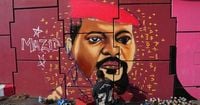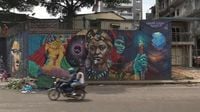In the bustling heart of Conakry, Guinea, the city’s once drab, concrete-heavy landscape is undergoing a remarkable transformation. Where gray, weathered walls once stood, now vibrant murals command attention, their colors and images reshaping not only the city’s appearance but also its collective spirit. At the center of this creative revolution is Omar Diaw, a Senegalese graffiti artist whose work is rapidly redefining both the streets of Conakry and public perceptions of art in West Africa.
It wasn’t so long ago that graffiti was widely dismissed as mere vandalism in Conakry. According to The Associated Press, less than a decade ago, such markings were seen as defacement—something to be scrubbed away rather than celebrated. But for Diaw, graffiti was never just about rebellion or making a mark. He saw it as a tool for public awareness, a way to spark conversation and reflection in a city hungry for new forms of expression. "Graffiti was seen as vandalism in Conakry not even a decade ago," Diaw said, reflecting on the skepticism he faced at the outset. "I decided to change minds by starting with public awareness murals."
And change minds he did. On Saturday, September 20, 2025, Diaw painted a striking mural of Guinea’s President Mamadi Doumbouya on a prominent street wall. Passersby paused to watch as Diaw worked, the president’s likeness emerging in bold strokes and vibrant hues. The mural quickly became a local landmark, drawing crowds and sparking conversation. The Associated Press captured the moment: "Passersby look on as graffiti artist Omar Diaw works on a mural depicting Guinea’s President Mamadi Doumbouya on a street wall in Conakry, Guinea." The scene was repeated across the city as Diaw’s work spread, each mural a new chapter in Conakry’s evolving visual story.
Diaw’s influence extends beyond portraits of political figures. On Sunday, October 19, 2025, motorcyclists rode past a mural depicting a powerful woman, her image towering above the street. Nearby, a mural of traditional dancers added a sense of movement and joy to the cityscape, while another, showing a smiling man with an elephant, brought a touch of whimsy and local flavor. These murals, curated and documented by AP photo editors, are more than just art—they’re a testament to a city in the midst of cultural renewal.
But what’s truly remarkable is how quickly attitudes have shifted. As recently as a few years ago, graffiti artists in Conakry faced suspicion and even hostility. Today, their work is seen as an undeniable part of the city’s identity. According to a recent report, "Graffiti has become an undeniable part of Conakry's crowded, concrete-heavy landscape as of October 24, 2025." Larger-than-life images of famous Guinean musicians and African independence leaders now dominate city walls, dwarfing even the overloaded trucks that rumble by.
The movement in Conakry draws inspiration from Senegal’s rich street art tradition. Senegalese cities like Dakar have long been known for their vibrant murals, and Diaw brings that legacy with him, adapting it to Guinea’s unique context. His art is not just decorative—it’s a statement, a form of public dialogue. By painting figures like President Doumbouya and powerful women, Diaw is inviting viewers to reflect on leadership, identity, and the role of art in society.
The impact of Diaw’s murals is evident in the way people interact with them. In one AP photograph, a street vendor walks past a mural of traditional dancers, her everyday routine momentarily intersecting with the world of art. In another, people stop to watch as Diaw adds the finishing touches to his depiction of the president. These moments capture the essence of street art: it’s accessible, immediate, and woven into the fabric of daily life.
Of course, not everyone was immediately won over. Some residents, recalling the city’s long-standing aversion to graffiti, worried that the murals might attract vandalism or send the wrong message. But as Diaw’s work proliferated, skepticism gave way to pride. The murals became rallying points, symbols of a city embracing change while honoring its heritage. "Larger-than-life images of famous Guinean musicians and African independence leaders now dwarf the overloaded trucks that drive by," noted a recent feature, highlighting the scale and ambition of the project.
Diaw’s success in Conakry is part of a broader trend across West Africa, where street art is gaining recognition as a legitimate and powerful form of expression. Cities from Dakar to Lagos are seeing their walls come alive with color and meaning, each mural a testament to the creativity and resilience of their communities. In Conakry, the change has been especially dramatic, with Diaw’s work serving as both catalyst and inspiration.
What’s next for Conakry’s street art scene? If Diaw’s vision is any indication, the possibilities are endless. He continues to work on new murals, each one pushing the boundaries of what public art can achieve. His influence is also inspiring a new generation of artists, eager to leave their own mark on the city. The hope, according to Diaw, is that street art will continue to evolve, becoming an integral part of Conakry’s identity and a source of pride for its residents.
As the city looks to the future, one thing is clear: the walls of Conakry will never look the same. Thanks to artists like Omar Diaw, what was once dismissed as vandalism has become a vibrant celebration of culture, history, and community. And for anyone walking the streets of Guinea’s capital today, the message is impossible to miss—art has the power to transform not just spaces, but hearts and minds as well.
With each new mural, Conakry’s story grows richer, its walls speaking volumes about the city’s past, present, and bold hopes for the future.

